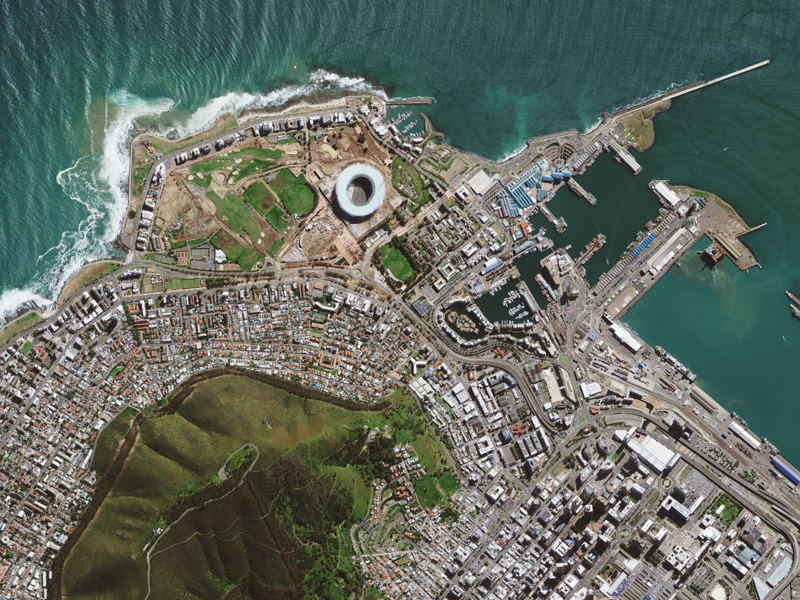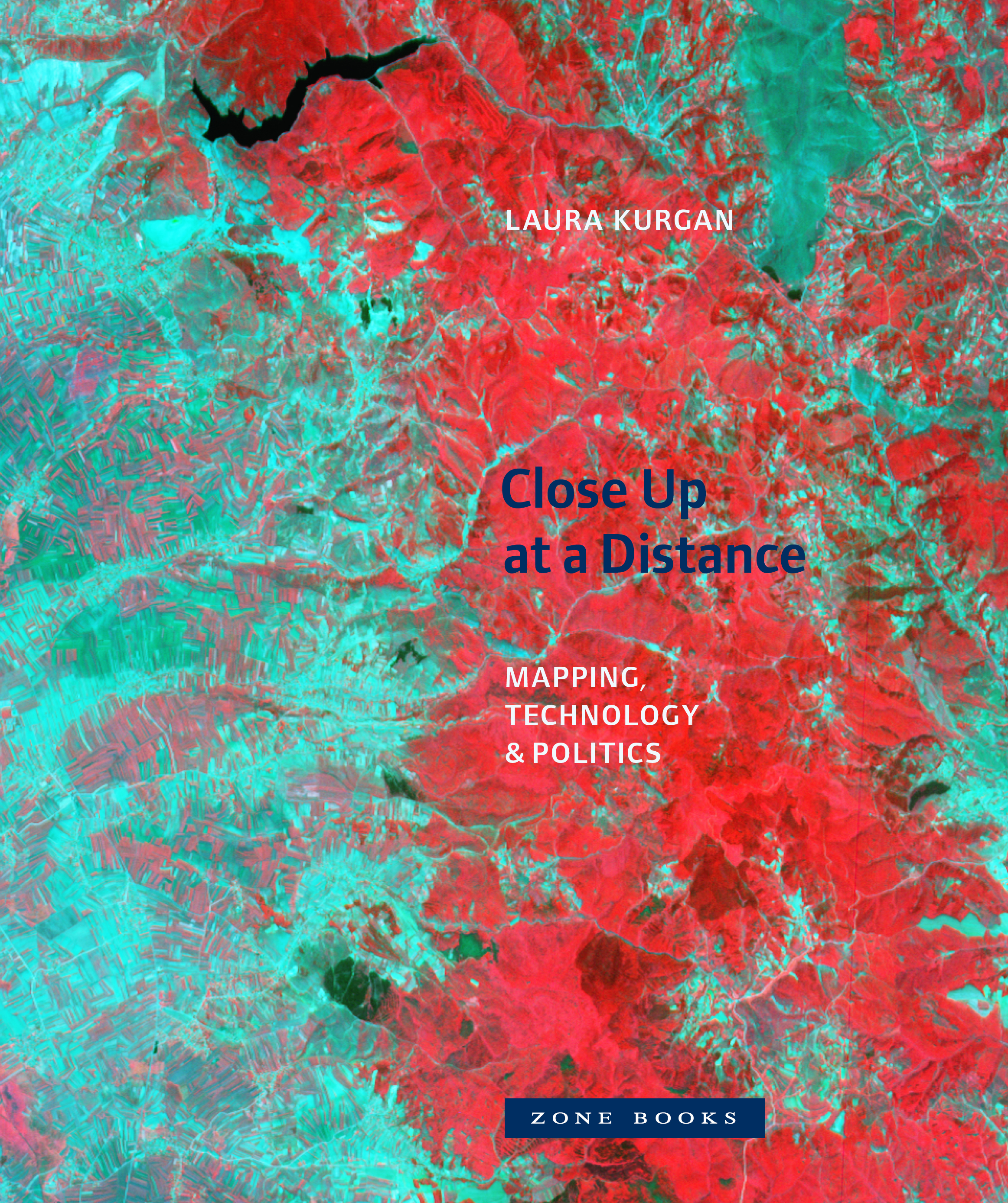Review of Close Up at a Distance: Mapping, Technology and Politics by Laura Kurgan (Zone Books).
by Dan Gettinger
Detractors of military drones claim that the physical distance that separates the pilots from their targets is problematic. Fighting a war by way of satellite link is admittedly a foreign idea, something akin to playing a video game rather than ‘real’ engagement. Yet, war is not the only human activity that is being transformed by advances in satellite technology. From mobile phones to online mapping services, our lives are increasingly tied to the services that satellites provide. In Close Up at a Distance: Mapping, Technology and Politics, Laura Kurgan asks what it means when we are increasingly viewing the world from the satellite’s perspective.
An associate professor of architecture at Columbia University, Kurgan focuses on maps in the digital age, the technologies that create them (mostly satellites), and their role as pixelated spatial representations of our world. In a thoughtful and patient exploration of this technology and the ways in which this perspective has been exploited in history, Kurgan problematizes the assumption that these images are objective and scientific. Kurgan wraps this book in questions about the function of reality within a digitally constructed space that relies on these images as an objective representation of realities, both physical and social.
The essential issue at stake in this book is the dual nature of these images. While they appear aesthetically as truthful representations of the Earth, they are also presented without the context in which they were taken. In an interview with Trevor Paglen at the Columbia Graduate School of Architecture, Planning, and Preservation, Kurgan explained how part of this book is an exploration of the history of the declassification of satellite imagery. Satellite image services, such as those offered by Google Earth, were once exclusively the domain of military and intelligence organizations; now, satellite imagery is an everyday part of the way in which we plan our lives. The overhead perspective, at first so chillingly foreign and at one point ridden with distinct political tones, is today a common visualization of the Earth. Anyone with an internet connection can access satellite images of basically every inch of the earth.
Mapping services such as Google Maps highlight both the prominence of this technology as well as the complexity of treating the overhead perspective as an objective source. Kurgan begins by acknowledging that:
“For many of us, maps now are as omnipresent as the more obvious utilities (such as electricity, water, gas, telephone, television, the Internet), functioning somehow like ‘extensions’ of ourselves, to co-opt Marshall McLuhan’s famous definition of media.”
It isn’t just Kurgan who understands the importance of maps. Google, Apple, and now Facebook are seeking to exploit the critical role that mapping services have come to play in our everyday lives. An article in the New York Times from earlier this week revealed the fierce competition between the three companies for access to mapping technology. John Malloy, a partner at the venture firm BlueRun Ventures, told the Times, “‘the future of search starts with maps. That’s where all the commerce is going to be done and that’s what everyone’s fighting out… to monetize mobile traffic, maps are a critical ingredient.’” The role of maps in our lives is expanding, and companies are recognizing the opportunity to translate that new reliance into profit.
This thinking has inspired Google to redesign their mapping services. In the new version of Google’s service, maps are tailored to suit the user, based on information about the user’s preferences – such as favorite restaurants and bars. By tracking the places a user frequently visits and the habits of like-minded people, Google Maps will provide recommendations for destinations in real time. According to Jonah Jones, the lead designer for the service, “‘Everybody gets their own map, every time.’” The further integration of the individual into the map grid is an expansion of what Kurgan claims is already a core function of maps: reinforcing, and perhaps even constituting identity. Maps, Kurgan explains, “show us where we are and how to get somewhere else, and in doing so, they can contribute to a sense of security and self-possession.” The assimilation of ourselves into a digital grid, of being a fixed point, gives us a sense of comfort in a similar way that the overhead perspective of satellites reassures us with the false guarantee that we are seeing a direct representation of the Earth, rather than one mediated by the technology of satellite imagery and, soon enough, one shaped by our own interests and preferences.
The growing and, in a sense, unseen, influence of satellites on our lives demands a reexamination of this technology and the accompanying assumption that it provides an unvarnished and truthful representation of the Earth.
“Identify an area,” Kurgan directs the reader, “zoom in and examine the specific conditions. Zoom out and then consider both scales at the same time. The resulting image is no longer hard data. It is a soft map that is infinitely scalable, absolutely contingent, open to vision and hence revision.”
Kurgan illustrates this argument with the example of Google Earth. The online service presents itself as “a smooth zoom,” allowing the individual user to access any point on the Earth from different vertical and horizontal access points. In reality, this unencumbered overhead perspective is “a patchwork of archived aerial and satellite images of varying origins, sources, motivations, and resolutions.” Until very recently, Google maps compiled imagery from a number of different private and government sources. While to us these images serve as reliable transcription of our landscapes and habitats, they only offer a narrow, problematic perspective, unless they are considered in the context of how they are recorded and assembled out of a multiplicity of perspectives.
Kurgan argues that the implied objectivity of the overhead perspective conceals the reality that these images have been interpreted. Satellite imagery, as much as we would like to take it as a factual representation of the Earth, cannot be considered to be ‘raw data.’ This understanding is what Kurgan calls para-empiricism, a recognition that data “means nothing more or less than representations, delegates or emissaries of reality.” Like ‘paramilitary’ or ‘paramedic,’ para-empiricism is means that data operates “alongside the world” and not in some realm of unquestionable obedience to truth.
“My claim is not that this plunges us into some abyss of uncertainty, though, or makes it impossible to function in the real world. On the contrary, it is only the condition of accepting this condition of data, in para-empirical condition, that we have any chance of operating responsibly in or on the world.”
The main problem with imaging technologies such as satellites or drones is that they “let us see too much, and hence blind us to what we cannot see, imposing a quiet tyranny of orientation that erases the possibility of disoriented discovery.” The overhead perspective lends a sense of understanding as if, peering down from Mt. Olympus, the beholder is all-knowing. We can easily forget that there is a definitive limit on what this imagery can convey.

Kurgan’s claim that image interpretation is an essential factor in satellite representations of our landscapes can be carried over into the drone debate. The debate about drone warfare is not just a debate about remoteness; it’s also about digital representations of human and natural space. I think we can learn something from Kurgan’s point in Close Up at a Distance, that the aerial perspective is more complicated than it appears. The arguments about whether the remoteness of drone warfare is a problem are, in a way, narrow visions of much broader issues about engaging with space and each other through digital mediums. The core issue at hand concerns the conceptualization of space; if we want to properly engage with the problem, we need to acknowledge that satellite imaging technologies – and, to a lesser or equal degree, drone technology – are the source of a major transformation of our world view. A transformation, one should note, that has occurred over the course of just two decades.
And yet, recognizing the complexity of these issues is of course just the beginning. When it comes to drones and satellites, technological innovation has outpaced our ability to consider its implications. Expertly and thoughtfully, Kurgan works to close that gap.
[includeme file=”tools/sympa/drones_sub.php”]

